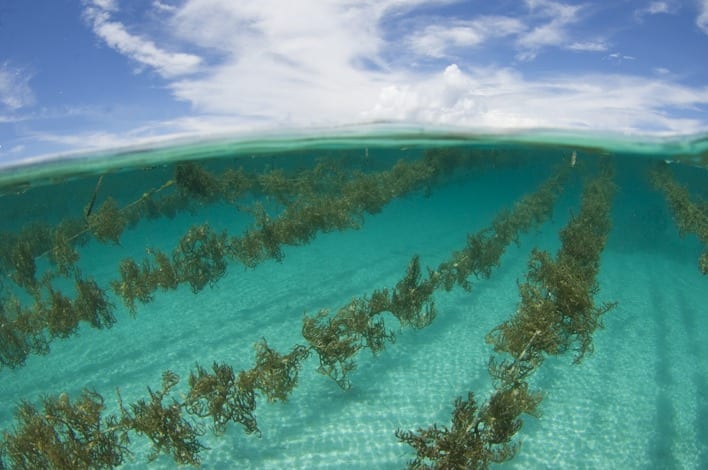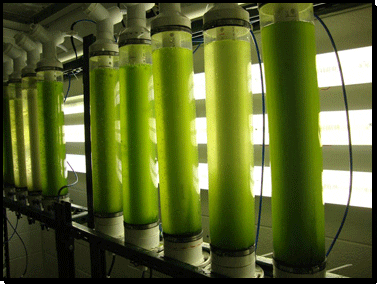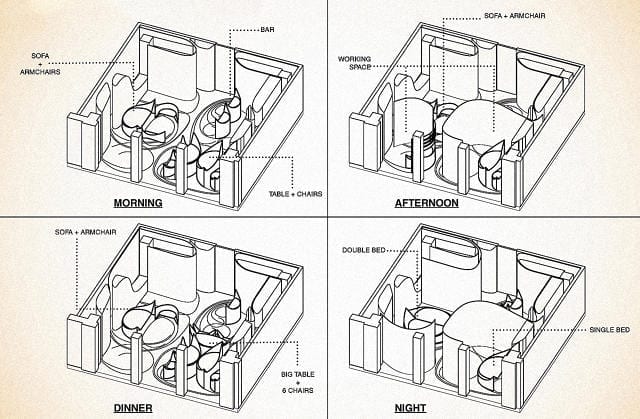
Meet the farm of the future, where common seaweed is being upgraded from an environmental problem to a valuable natural resource and raw material
“The fact is that algae can absorb nitrogen from the water as effectively as a wastewater treatment plant,” says Gröndahl, a KTH Royal Institute of Technology researcher and head of the Seafarm project, which converts algae into eco-friendly food, medicine, plastic and energy.
The excessive fertilisation (eutrophication) of our seas results in an over-production of algae, commonly known as seaweed. Bathing beaches become unusable on account of algae blooms and entire ecosystems can be threatened.
“But, in our research, we turn the argument on its head and see algae as a resource. We collect excess algae along the coasts and cultivate new algae out at sea,” Gröndahl says.
Already, seaweed is getting scooped up from the Baltic Sea, along Sweden’s southern coast, in order to be converted to biogas. The coast is rich with the seaweed. The city of Trelleborg estimates that its beaches host an excess of algae that is equivalent to the energy from 2.8 million litres of diesel fuel.
Almost three quarters of the earth’s surface is covered by sea, and the seas possess as great a production capacity as the land. At the present time, humankind utilises 40 per cent of the production from land-based ecosystems whereas only 1 per cent of the seas’ ecosystems are currently utilised.
Unfortunately, this percentage at present consists largely of ruthless exploitation; where the fishing industry trawls up every living thing and hoovers the sea bottoms. “We really need new solutions, such as harvesting the excess algae for fuel and cultivating new, pure algae for special products and foodstuffs,” Gröndahl says.
Gröndahl points out that algae contain vitamins, amino acids and minerals, indeed the entire list of the periodic elements, including iron. Algae may be eaten directly or cooked; and in recent years an interest in algae products in foodstuffs has increased in Sweden, thanks in part to the popularity of Asian food culture. Even spices and cooking oil can be produced by algae.
The brown algae known as sugar kelp (Saccharina latissima), for example, contain up to three times as much sugar as sugar beet. “Of course, it’s unwise to burden the earth with oil palm and sugar beet cultivation when corresponding products can be produced in an ecologically sustainable way from algae,” explains Gröndahl.
Algae may, in the future, be an ingredient of animal feed to replace the environmentally damaging fish meal which is common in pig and poultry diets.
Furthermore, salmon today is fed with fishmeal from wild caught fish, and calculations show that no less than 5 kg of wild fish go to produce 1 kg of farmed fish.
“Clearly, it’s not a good idea to feed fish with fish. Algae feed, in this case, will be of great benefit for the environment,” he says. “What’s more, we’re counting on Seafarm’s cultivation of algae being able to favour the marine environment as a whole, since they form secondary reefs in free bodies of water. This sort of reef attracts fish and other animal species.
The Latest on: Seaweed farming
[google_news title=”” keyword=”Seaweed farming” num_posts=”10″ blurb_length=”0″ show_thumb=”left”]
via Google News
The Latest on: Seaweed farming
- NJ beer lovers need to check out this new brewery in Farmingdaleon April 28, 2024 at 5:23 am
North Dakota is one of the top states for beer consumption per capita, according to VinePair. A 2020 report shows that as with Montana, Vermont, and New Hampshire, beer is the most preferred beverage ...
- A leader in US seaweed farming preaches, teaches and builds a wider networkon April 27, 2024 at 4:42 am
A leader in US seaweed farming preaches, teaches and builds a wider network Bren Smith and his GreenWave organization are helping lay the foundations for a generation of seaweed-growing farmers in the ...
- Farm suicides, anger haunt Indian villages that Modi promised hopeon April 27, 2024 at 3:34 am
LIKE everyone else around him, Vithal Rathod was excited for what the future held for him and their village when Narendra Modi became India’s prime minister on May 26, 2014. Just two months earlier, ...
- Kilwa's plea for support in revolutionizing seaweed farmingon April 27, 2024 at 3:26 am
SEAWEED farmers in Kilwa district, Lindi region are seeking support to modernize their operations by acquiring state-of-the-art seaweed processing machines. They are reaching out to stakeholders ...
- Mars Snacking, Unreasonable Group Announce New Cohorton April 26, 2024 at 9:15 am
Mars recently unveiled its innovative open-source action plan—the Mars Net Zero Roadmap—to accelerate action toward achieving Net Zero emissions, which includes a new target to cut carbon in half by ...
- British shellfish and seaweed farms could provide valuable habitats for coastal fish species, according to new researchon April 26, 2024 at 12:54 am
Shellfish and seaweed farming offer potentially sustainable food sources and are increasingly recognised for their additional environmental benefits, but research into their value for fish populations ...
- Red seaweed was billed as a gamechanger for livestock methane reduction… so when will it deliver?on April 23, 2024 at 9:33 am
Seaweed is the most promising tool in the enteric methane reduction toolkit, but there are challenges to growing it at scale says FutureFeed.
- Meet the “Mwani Mamas,” a Group of Zanzibari Women Changing Their Lives Through Seaweed Farmingon April 22, 2024 at 3:58 am
Through learning to transform seaweed into products for the local beauty brand Mwani, they’ve become the first generation of women in Zanzibar to achieve financial independence.
- Why an ex-Googler just opened a chestnut farm in rural Pennsylvaniaon April 18, 2024 at 2:30 am
Can regenerative farming also regenerate communities? This Black farmer believes so. Can regenerative farming also regenerate communities? This Black farmer believes so.
- Maine Seaweed Week is a celebration—and you’re invitedon April 15, 2024 at 1:28 pm
The sixth annual Maine Seaweed Week will feature everything from farm tours to cooking classes to kelp burgers.
via Bing News










